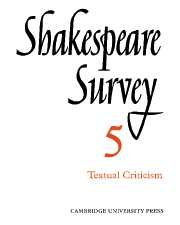Book contents
- Frontmatter
- Restoring Shakespeare: The Modern Editor’s Task
- Suggestions Towards an Edition of Shakespeare for French, German and Other Continental Readers
- The 1622 Quarto and the First Folio Texts of Othello
- An Approach to the Problem of Pericles
- The Shakespeare Collection in the Library of Trinity College, Cambridge
- New Place: The Only Representation of Shakespeare’s House From an Unpublished Manuscript
- Letters to an Actor Playing Hamlet
- Shakespeare’s Imagery: The Diabolic Images in Othello
- Suggestions for a New Approach to Shakespeare’s Imagery
- Shakespeare’s Influence on Pushkin’s Dramatic Work
- Shakespeare on the Flemish Stage of Belgium, 1876–1951
- International Notes
- Shakespeare Productions in the United Kingdom: 1950
- Shakespeare in the Waterloo Road
- The Year's Contributions to Shakespearian Study 1 Critical Studies
- 2 Shakespeares’s Life, Times and Stage
- 3 Textual Studies
- Books Received
- Index
- Plates
The 1622 Quarto and the First Folio Texts of Othello
Published online by Cambridge University Press: 28 March 2007
- Frontmatter
- Restoring Shakespeare: The Modern Editor’s Task
- Suggestions Towards an Edition of Shakespeare for French, German and Other Continental Readers
- The 1622 Quarto and the First Folio Texts of Othello
- An Approach to the Problem of Pericles
- The Shakespeare Collection in the Library of Trinity College, Cambridge
- New Place: The Only Representation of Shakespeare’s House From an Unpublished Manuscript
- Letters to an Actor Playing Hamlet
- Shakespeare’s Imagery: The Diabolic Images in Othello
- Suggestions for a New Approach to Shakespeare’s Imagery
- Shakespeare’s Influence on Pushkin’s Dramatic Work
- Shakespeare on the Flemish Stage of Belgium, 1876–1951
- International Notes
- Shakespeare Productions in the United Kingdom: 1950
- Shakespeare in the Waterloo Road
- The Year's Contributions to Shakespearian Study 1 Critical Studies
- 2 Shakespeares’s Life, Times and Stage
- 3 Textual Studies
- Books Received
- Index
- Plates
Summary
It is generally held that the 1622 Quarto and the Folio texts of Othello were printed from different manuscripts, that the manuscript used for the Quarto was a transcript, and that a transcript also possibly intervened between the foul papers and the Folio. But no one seems very happy about Othello’s textual history and I suspect it was very different from what is generally believed.
Until the question of the relationship of the extant printed texts is settled we cannot begin to guess at the character of the manuscripts, no longer extant, which lay behind them. It is my main purpose in what follows to show that the Quarto and Folio texts were not independent prints but that the Folio was printed from a corrected copy of the Quarto. I have finally suggested that the well-recognized inferiority of the Quarto text was due not to scribal errors but to memorial contamination.
The general superiority of the Folio text has never been questioned and we can safely assume that the manuscript which lay behind it was of good authority. In most cases where the texts differ it is immediately apparent that the Folio readings are better than those of the Quarto. But it is as well to understand the cause of the Quarto's inferiority in cases where the Folio reading is preferable, and it is even more important to be in a position to assess how far Quarto readings can safely be substituted where the Folio variants are unsatisfactory.
- Type
- Chapter
- Information
- Shakespeare Survey , pp. 16 - 24Publisher: Cambridge University PressPrint publication year: 1952

